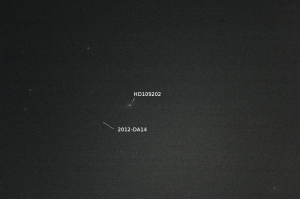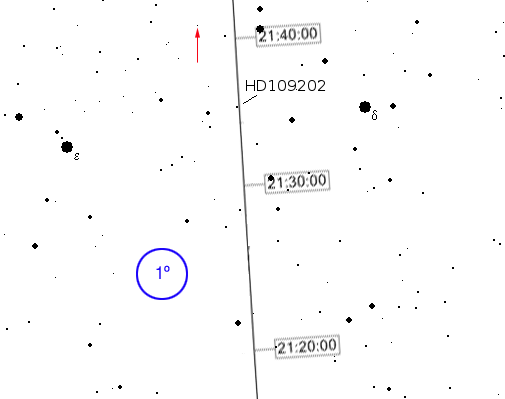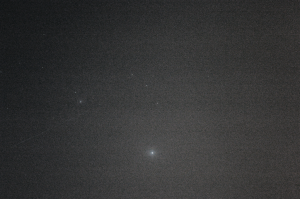Asteroid 2012-DA14 was on a collision course with Earth, that’s what the loonies were telling us, so I thought it would be a good opportunity to see if I could image the track of this passing lump of rock.
At only 45 meters across this isn’t a big asteroid but being closer than some of our communications satellites it was just bright enough to catch with my telescope and Canon 300D camera.
I use Cartes du Ciel as my “star map” these days and this asteroid isn’t in the catalogue so I was starting to think I was going to miss this “near miss” event. Eventually I found some star charts on the popastro web site and by comparing star positions with those on the sky map I was able to work out roughly where the asteroid would be at a given time (give or take a minute).
I set the computer to take 60 second images with 30 seconds between each to allow enough time for them to download (USB 1 is very slow). Starting at around 20:30 I ran some practice shots knowing that my best chance was when the asteroid was due to pass star HD109202 at approximately 21:35.
I followed the path of the Asteroid on my sky chart and every 5 minutes or so I ran a set of between 3 and 5 images to see if I could see the track. After quickly reviewing some of the images while waiting for the telescope to slew to a new position, I wasn’t able to see any sign of the asteroid. Even more of an issue was the thickening clouds that had started to roll in, this was beginning to look like a lost opportunity but I continued to shoot just in case.
I kept a log of image numbers in a text file so that I’d know which frames where from which batch so if I had to do any heavy processing I’d know which frames were most likely to contain the tell tail streak of an object moving at a different speed to the backdrop of stars.
Imagine my surprise when I copied the images onto my main PC for processing and found that I’d caught at least 1 frame from each of the sets I’d taken except the very last which was too cloudy.
Given the guess work that went into pointing the scope at an empty spot roughly between these 2 points and the guessing at what time the asteroid would reach that imaginary spot I’m very happy with the outcome.
Of course images with trails like this are usually discarded as they’re caused by satellites or planes so I’ll have to make sure these are labelled correctly so I don’t throw them away in the future.
So here it is – 2012-DA14 appearing to originate from HD109202 and travelling down towards the bottom left of the image.
and here’s an extract from the popastro image that I used to find it:-
The apparent magnitude was expected to be greater than 9 at this time but I’ll have to update with more accurate info as I find it.
If you want to measure the apparent velocity of the asteroid you can do it by measuring the track (how far it travelled in 60 seconds) and using the pixel resolution of the Canon 300D and knowing my telescope is 1200mm F/L with an aperture of 252mm. The image has been shrunk form the original 3066 pixels wide to 1024 for the web so you’d need to adjust for that … I say you, because I’ll look it up on the NASA website ![]()
Here’s another image of it:



